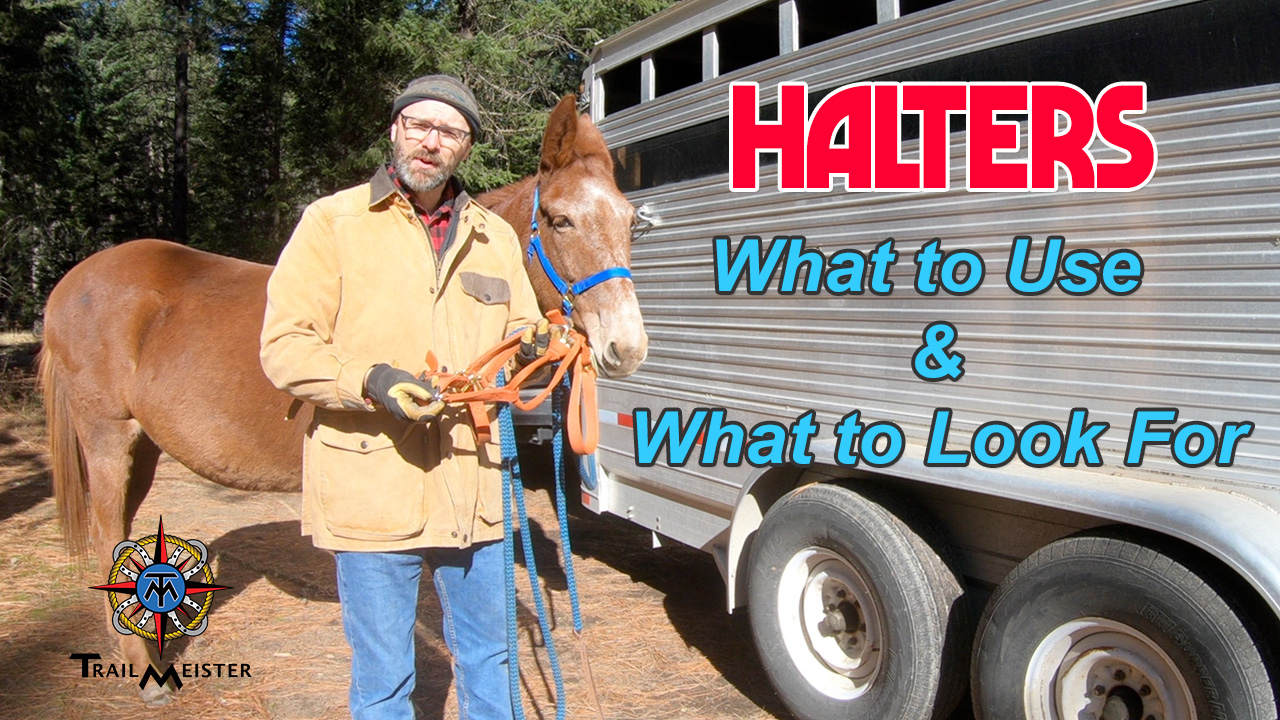Horse Halters – How and why!
If you’ve got a horse, or a mule, you have a halter. It may be plain, fancy, or have special uses, but you’ve got one or several of these pieces of tack laying around. Let’s take a peek at some of the different types of halters you find around the barn and spend a little time talking about how and when they’ll be used.
All halters perform the same basic functions. They provide a tool for controlling horses’ movements during handling. But all halters aren’t equal. Not every halter is going to suit your needs any more than every halter is going to fit your horse’s head perfectly.
The Big Three:
I lump my halter collection into 3 piles. Flat, Round, and Special Purpose. Let’s check them out.
FLAT
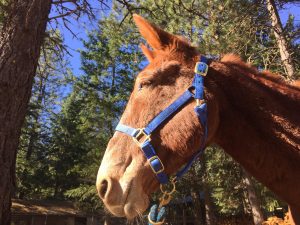 As the name implies flat halters are flat. Generally made of strips of flat nylon webbing or leather, connected with metal rings and buckles.
As the name implies flat halters are flat. Generally made of strips of flat nylon webbing or leather, connected with metal rings and buckles.
Flat Halter Materials
Nylon – Available in a variety of colors and patterns, these halters stand up to the weather and resist abrasion. Nylon halters are very strong and they’re easy to wash, and care for. With its wide webbing a simple nylon halter is my go to tool for trailering.
Leather – Leather halters look terrific! They offer plenty of strength and durability as long as they’re well taken care of. Well taken care of is of course the point here. Despite the classic look, feel, and smell of leather I’d rather be riding than cleaning and oiling leather.
Fitting a Flat Halter
Flat halters come in a variety of sizes such as Cob, Full, and more. Sizing your halter correctly is important not only for appearance, but also functionality, ensuring it stays in place properly and is comfortable. To fit your flat halter properly, be sure to use the adjustment points on the crownpiece and noseband. The crownpiece should fit comfortably behind your horse’s ears without pinching. The noseband should sit about halfway between your horse’s nostrils and eyes, with about two to three fingers width between the leather and your horse’s nose. The throatlatch should allow for three to four fingers width so your horse can breathe and swallow properly, but won’t get a hoof caught. Finally, be sure that the hardware is not too tight. Properly fitted flat halters evenly distribute pressure and are ideal for trailering.
We like these from Weaver Leather – https://amzn.to/361NTus
ROUND
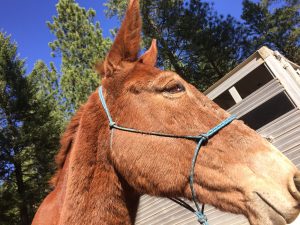 Round, or rope, halters are my favorite type of halters for around the barn and on the trail. Rope halters are created from a single piece of rope and forego hardware attachments that are prone to failure, found in flat halters. Because rope halters don’t involve any hardware, they are much stronger than flat styles and offer an unfettered connection between handler and horse, allowing for the development of subtle cues. I use rope halters when practicing groundwork at home, under a bridle when trail riding, and when camping with a highline.
Round, or rope, halters are my favorite type of halters for around the barn and on the trail. Rope halters are created from a single piece of rope and forego hardware attachments that are prone to failure, found in flat halters. Because rope halters don’t involve any hardware, they are much stronger than flat styles and offer an unfettered connection between handler and horse, allowing for the development of subtle cues. I use rope halters when practicing groundwork at home, under a bridle when trail riding, and when camping with a highline.
For camping we like these reflective rope halters – https://amzn.to/3l7RIol
How They Work
Rope halters are thinner than leather or nylon halters so the pressure is more focused versus being distributed across a wider area. As a result, a rope halter can apply a bit of pressure when you want to reinforce a cue.
Tying a Rope Halter
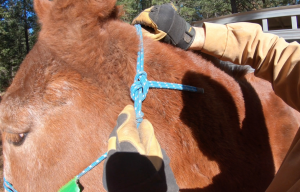 Rope halters may not be as instinctual to put on as a flat, but with a little practice the process will become second nature. A correctly tied rope halter is secured with a sheet bend knot that points back towards the rump.
Rope halters may not be as instinctual to put on as a flat, but with a little practice the process will become second nature. A correctly tied rope halter is secured with a sheet bend knot that points back towards the rump.
How to Properly Tie a Rope Halter in 4 Easy Steps:
- Stand on the near side (left side) of your horse. Reach over the neck and grab the poll strap with your right hand.
- Slide the noseband over the horse’s nose and the throat knot upwards below the jaw.
- Take the end of the poll strap pointing towards you and run it through the tie loop.
- Run the end of the poll strap behind the loop and then tuck through the space between the loop and the strap. For the more technically inclined what you just did was create a sheet bend knot! – Make sure that the pointy end is pointing towards your animal’s butt and away from his eye!
HERE’S A VIDEO ON HOW TO PROPERLY TIE A ROPE HALTER
https://www.trailmeister.com/the-rope-halter-are-you-tying-it-right/
SPECIAL PURPOSE HALTERS
There are many types of special purpose halters available from grooming to shipping. The two most common special purpose halters that I see are leading / packing halters and breakaway halters.
Leading / Packing
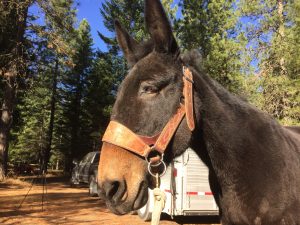 Also known as side pull halters these tools help keep an animal that you’re ponying from pulling back on you while going down the trail. The halter tightens as they pull back and the animal quickly learns that the easiest way down the trail is without pulling. These can be found with chain or leather pulls. I like my “come along nicely” halters to have a wide leather nose piece so they’re a bit more comfortable.
Also known as side pull halters these tools help keep an animal that you’re ponying from pulling back on you while going down the trail. The halter tightens as they pull back and the animal quickly learns that the easiest way down the trail is without pulling. These can be found with chain or leather pulls. I like my “come along nicely” halters to have a wide leather nose piece so they’re a bit more comfortable.
Breakaway Halters
These flat style halters typically have a breakable crown piece that act like a fuse in the case something exciting happens. My preference is I don’t want my equipment to break. If a horse tied with a breakaway halter gets free a time or two, he has been trained to walk away whenever he wants. That could be a very bad thing. For me the risks from running free outweigh those of staying put. Lost horses in the wilderness rarely come to good ends. Even in a front country camp a free roaming equine can cause injury to others. For those reasons I choose to avoid breakaways, you’ll have to decide what works best for you.
I spend a significant amount of time with my animals and they have earn the privilege of being tied. Until I can reliably saddle and unsaddle without the aid of tying, my animal’s aren’t ready for the trail or the opportunity to rest and relax while parked to a trailer, tree, or highline.
I also hear from people who say they keep halters on their animal’s so they can catch them. To that I say that both human and beast need more training. Teach your critters to come when called.
As always for practical information on trail riding and camping with horses, as well as the largest guide to trails and camps visit us at www.TrailMeister.com


